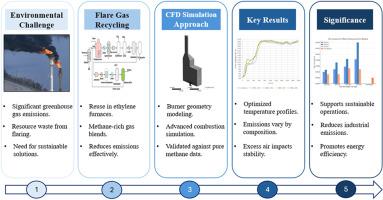乙烯裂解炉再生火炬气燃烧特性及排放的数值分析
IF 10
1区 环境科学与生态学
Q1 ENGINEERING, ENVIRONMENTAL
引用次数: 0
摘要
燃烧碳氢化合物气体是石油化工厂的常见做法,会造成大量温室气体 (GHG) 排放和资源浪费。本研究使用 ANSYS Fluent 进行计算流体动力学 (CFD) 模拟,研究了石化应用中工业燃烧器中回收火炬气混合物的燃烧特性和排放情况。研究考察了三种不同成分(10-40%)的火炬气混合物的行为,以及过量空气水平(10-50%)对温度曲线、火焰稳定性和排放的影响。结果表明,混合物 1 富含碳氢化合物,在 30-40% 的火炬气水平下燃烧稳定,达到峰值温度,而在 10-20% 的火炬气水平下燃烧不稳定。甲烷含量较高的混合物 2 在 40% 的燃烧水平下表现最佳,可提高热量保持率,但较低的水平则会因湍流而降低稳定性。混合物 3 含有较轻的碳氢化合物,总体上仍不稳定,但在 30% 和 40% 的燃烧水平下,由于能量释放延迟,燃烧性能有所改善。引入 10-20% 的过量空气可提高稳定性,但超过 30% 的水平则会损害热效率。排放趋势表明,富含甲烷的混合物会增加二氧化碳和氮氧化物,而较轻的混合物会减少氮氧化物,但会遇到稳定性方面的挑战。这些见解为石化燃烧器中火炬气利用的优化策略提供了参考。本文章由计算机程序翻译,如有差异,请以英文原文为准。


Numerical analysis of combustion characteristics and emissions of recycled flare gas in ethylene cracking furnaces
Flaring hydrocarbon gases is a common practice in petrochemical plants, contributing to significant greenhouse gas (GHG) emissions and resource wastage. This study investigates the combustion characteristics and emissions of recycled flare gas mixtures in an industrial burner for petrochemical applications using computational fluid dynamics (CFD) simulations in ANSYS Fluent. The research examines the behavior of three flare gas mixtures with varying compositions (10–40 %) and the influence of excess air levels (10–50 %) on temperature profiles, flame stability, and emissions. Results indicate that Mixture 1, rich in hydrocarbons, stabilizes combustion at 30–40 % flare levels, achieving peak temperatures, while instability occurs at 10–20 % flare levels. Mixture 2, with high methane content, performs optimally at 40 % flare, enhancing heat retention, but lower levels reduce stability due to turbulence. Mixture 3, containing lighter hydrocarbons, remains unstable overall but shows improved combustion performance at 30 % and 40 % flare levels due to delayed energy release. Introducing 10–20 % excess air enhances stability, but levels beyond 30 % impair thermal efficiency. Emission trends indicate methane-rich mixtures increase CO2 and NOx, while lighter mixtures reduce NOx but encounter stability challenges. These insights inform strategies for optimizing flare gas utilization in petrochemical burners.
求助全文
通过发布文献求助,成功后即可免费获取论文全文。
去求助
来源期刊

Journal of Cleaner Production
环境科学-工程:环境
CiteScore
20.40
自引率
9.00%
发文量
4720
审稿时长
111 days
期刊介绍:
The Journal of Cleaner Production is an international, transdisciplinary journal that addresses and discusses theoretical and practical Cleaner Production, Environmental, and Sustainability issues. It aims to help societies become more sustainable by focusing on the concept of 'Cleaner Production', which aims at preventing waste production and increasing efficiencies in energy, water, resources, and human capital use. The journal serves as a platform for corporations, governments, education institutions, regions, and societies to engage in discussions and research related to Cleaner Production, environmental, and sustainability practices.
 求助内容:
求助内容: 应助结果提醒方式:
应助结果提醒方式:


